Swords, York Sunbury Historical Society, Fredericton Region Museum artefacts
York Sunbury Historical Society, Fredericton Region Museum, artefacts, Swords
Musée de la région de Fredericton, Épées
A sword is an edged, bladed weapon intended for manual cutting or thrusting. Its blade, longer than a knife or dagger, is attached to a hilt and can be straight or curved. A thrusting sword tends to have a straighter blade with a pointed tip. A slashing sword is more likely to be curved and to have a sharpened cutting edge on one or both sides of the blade. Many swords are designed for both thrusting and slashing. The precise definition of a sword varies by historical epoch and geographic region.
The Fredericton Region Museum (FRM) has a good number of interesting artifacts, including an excellent collection of swords from various eras in our history. These are a few examples.
.avif)
(York Sunbury Historical Society, Fredericton Region Museum Collection, Author Photo)
(Accession No. 1969.2411.1).
British Infantry Officer's sword, P1822 with a "Wilkinson type" blade introduced in 1845. The sword is engraved with C. Webb 23 Old Bond St, London, and was retailed by Charles Webb who traded under this name and address between 1837 and 1857. This sword dates to sometime between 1845 and 1857. The sword has a brass hilt and butt, a sharkskin handle and a crown over Queen Victoria’s cypher on the basket. There is a Damascus Star (two interlocking triangles denoting a form of strength) on the blade just below the cypher. The sharkskin grip is most likely made from a Dogfish. The floral pattern on the blade represents the Flowers of the Union. This type of sword is also known as a 'gothic' hilt pattern due to the arches apparently mimicking gothic architecture. The sword has a metal scabbard with carrying two rings.
The gothic hilted swords were a family of swords carried by officers and some NCOs of the British Army between 1822 and the present day. They were primarily infantry swords, although they were also regulation pattern for some other officers such as surgeons and staff officers. The term "Gothic hilt" is derived from a perceived similarity between the curved bars of the guard and the arches found in Gothic architecture. They were elegant aesthetically pleasing weapons, although they were considered by some to be mediocre fighting swords. The weapon and its variants had a very long service life. They were replaced ultimately by the 1897 pattern British infantry officer's sword, first having the 1822 pipe-back blade replaced by the 1845 fullered blade, then the 1845 type blade replaced by a new thrusting blade in 1892 and then receiving a new steel hilt in 1895, which was then updated slightly in 1897.
Although infantry sergeants' and cavalry troopers' swords were issued by the army, officers were expected to purchase their own equipment. In theory they were required to purchase a sword which conformed to an official pattern, however some regiments had their own peculiarities and some allowed their officers some leeway in specification, so there are variations between individual pieces. Also, minor differences between individual manufacturers' examples exist, partly due to their own unique interpretations of the specification for the weapon. Lastly, officers could in fact purchase a blade of their own choosing if they cared to, so long as it looked more or less regulation when worn in the scabbard. Therefore, the precise length, curvature and width of blades varies between examples, with a small number of officers choosing entirely different types of non-regulation blade. Companies like Wilkinson of Pall Mall sold officers' swords in a variety of lengths, curves, widths and styles, while all conforming more or less to the basic regulations for each branch of the service.
The 1822 dress regulations mandated the introduction of a new sword, to replace the 1803 flank officer's sabre and the spadroon bladed 1796 line infantry officer's sword.The sword featured a 32.5-inch-long (830 mm), slightly curved blade of what was known as the 'pipe-back' design, a cross-section sometimes referred to as 'key-hole' shape in Victorian sources. This consisted of a flat, un-fullered, single edged blade with a nearly straight rod running along the back of the blade, with a 'false-edge' being formed on the back edge near to the tip, sometimes described as a 'quill-point'. This style of blade seems to have been the innovation of the maker Prosser of Charing Cross, London, and first appeared on 1796 light cavalry style blades from around 1810–1815. This cross-section was then translated to the new narrower 1822 infantry officers' sword. The 1822 blades generally featured acid etched decoration showing the monarch's monogram and other devices. The pipe-backed blade is very light for its size and has a very fine edge.The gilded brass, 'half-basket' hilt featured the characteristic Gothic outline, with the monarch's monogram formed in the guard. The hilt had an ornate one piece pommel and 'backstrap' enclosing the end and back of the grip, held in place by a ribbed brass ring at the top of the grip and a tang nut or peened rivet at the end of the pommel. The inside section of the guard folded on a hinge towards the blade, to allow the sword to rest easily against the wearer's side when worn. The wooden grip was covered in shark skin, known as shagreen, to give a textured surface for a secure grip, and this was wrapped with brass, copper or silver twist-wire in the recesses of the ribbed grip. Although the pipe/rod reinforcing at the back edge of the blade was intended to add rigidity for the thrust and strength/mass for the cut, the blade was rather flexible and light at the centre of percussion when made in the infantry sword size. The half basket guard gave better protection to the hand than its predecessor, the 1796 pattern, however the brass could be fragile on some examples, as illustrated by many surviving examples having damage or repairs. Later in the 19th century, it was noted in many articles on British military swords (including the lecture of John Latham of Wilkinson swordmakers in 1862) that these brass guards were vulnerable to hard blows from strong cutting swords such as Indian tulwars. (Wikipedia)
.avif)
(York Sunbury Historical Society, Fredericton Region Museum Collection, Author Photo)
(Accession No. 1969.2411.1).
British Infantry Officer's sword, P1822 with a "Wilkinson" type blade introduced in 1845.
In 1845, the pipe backed blade was replaced by Henry Wilkinson's design. This was a slightly curved cut-and-thrust blade, generally of the same length of the previous pattern, however the new blade featured a single, wide fuller and a flat back, rather than the pipe back, with a symmetrical spear-point rather than the quill-point. In essence it was a curved backsword blade with an improved point. It was a slightly heavier and more robust blade than the 1822 pipe-back. This new blade was also carried over onto cavalry, engineers and artillery officer's swords in 1845 and to naval officer's swords in 1846.
The hilt remained essentially unchanged from the 1822 pattern, although there was a tendency for brass guards after 1845 to be made somewhat thicker and more robust than previously. The hinged guard flap, which had been standard (if not universal) from 1822, started to disappear in the 1850s, to be replaced by a solid brass guard almost universally after around 1860. This change to the hilt is sometimes referred to as the '1854 pattern', but it was not technically a 'pattern' and the change seems to have happened at the end of the 1850s generally. Therefore, there is no actual '1854 pattern' other than the Foot Guards sword (details below). Wilkinson were still making infantry officers' swords with folding inner guards until 1859 as standard and do not seem to have switched to universally solid guards until 1860. The 1845 blade remained the same.
Direct comparison of the 1822 and 1845 blades shows that the new weapon was an improvement, being stiffer in bending and compression. It had a more robust edge, was a little heavier, had more mass in the centre of percussion and the symmetrical spear-point is much better at penetrating. The blade is better therefore at cutting, thrusting and guarding. Contemporary views on the new blade were favourable and it was almost universally adopted within a year. It was also adopted and embraced by experienced combat officers ordering fighting swords who could have chosen any type of private purchase blade (for example Major Hodson and Brigadier-General Jacob both chose this blade type for their custom fighting swords, which survive in the National Army Museum and Royal Armouries respectively) and it was emulated by various foreign militaries. Original sharp examples and replicas perform well in cutting tests, easily equalling other backsword and sabre types.
During the period of the 1845 blades use on infantry officers' swords, from 1845 to 1892, it has been observed that blades tended to get straighter. This is a general tendency, but was not universal. One can find early examples with straighter blades and later examples with more curved blades. The curvature varied, though it is fair to say that more straight examples seem to appear from later dates. The width of the blades were usually 1+1⁄8 inches (29 mm), but some examples were only 1 inch (25 mm) wide, and again these narrower ones tend to be later in date. Again this is a general tendency and not a rule. 'Piquet' or dress weight examples were made with much narrower blades and correspondingly smaller hilts. The standard length of these blades was 32.5 inches (830 mm), but again there was variation, with officers basically being allowed to order whatever length best suited them. Most surviving examples are 32.5 to 34.5 inches (830 to 880 mm). Thickness or mass of blades also varied and different examples can feel quite diverse in the hand. Some are balance to be better cutters while others make better thrusting swords. (Wikipedia)
.avif)
(York Sunbury Historical Society, Fredericton Region Museum Collection, Author Photo)
(Accession No. 1969.2411.1).
British Infantry Officer's sword, P1822 with a "Wilkinson" type blade introduced in 1845.
The 1845 sword enjoyed a long service life and was used successfully in colonial wars all over the world, often winning the praise of British soldiers who used it to defend their lives. However, in 1892 proponents of the theory that thrust should be used exclusively over cutting for swords prevailed and the cut and thrust blade was replaced by a straight dedicated thrusting blade with a thick, fullered, dumbbell section and a very acute narrow tapered point. Unburdened by the design compromises of a requirement to cut well, this was a triumph of academic theory over real world experience, but was generally well received (Robson reports on its good performance against the Dervishes in the Sudan. It was during the Sudan campaign when a young Winston Churchill sheathed his (cavalry) sword before the charge and used his then modern Mauser Broomhandle semiautomatic pistol). The 1892 blade is difficult to compare to the 1845 blade using historical accounts, because after 1892 there were comparatively far fewer encounters where swords were actually used.In 1895, the brass Gothic hilt was replaced by a steel hilt for line infantry officers, featuring a totally new design of both the guard and the handle. This was married to the 1892 thrusting blade to create an entirely new sword. Accompanying this was a new Sword Exercise system of 1895, promoted by Colonel Fox of the Army Gymnasia and devised by Maestro Masiello of Florence. (Wikipedia)
.avif)
.avif)
.avif)
(York Sunbury Historical Society, Fredericton Region Museum Collection, Author Photo)
(Accession No. 1969.2411.1).
British Infantry Officer's sword, P1822 with a "Wilkinson" type blade introduced in 1845.









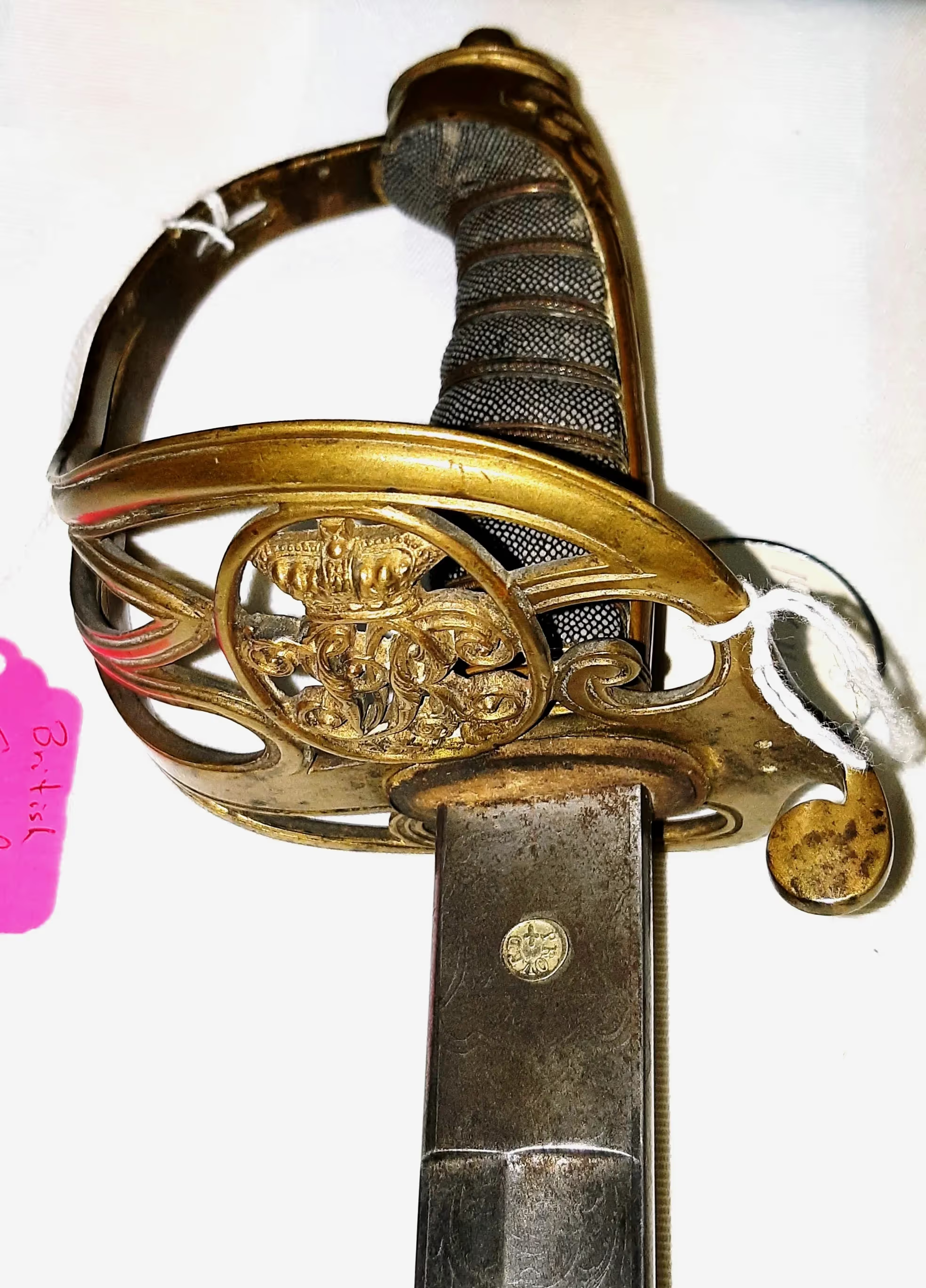


(Author Photos)
(Accession No. 1986.11.1).
British Infantry Officer's Sabre, 1845 pattern, steel blade, with crown and flat crest. The blade etched with a QueenVictoria cypher, "Furmin & Sons, 153 Strand, 13 Conduit St, London". B: Stamped. Firmin and Sons were located at that specific address from 1856 to 1860 narrowing the date-range for the sword's manufacture. Firmin and Sons are still in operation.




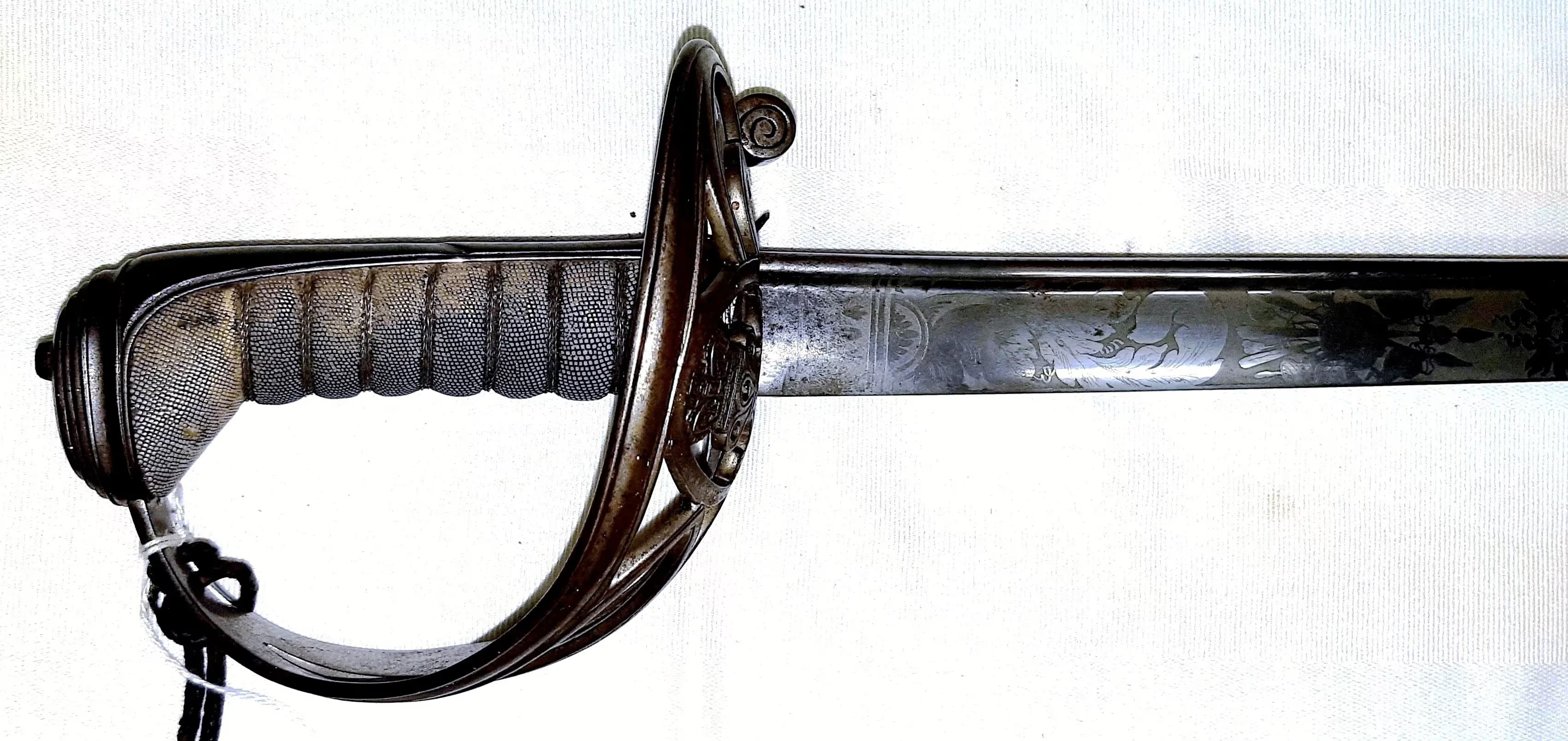


(Author Photos)
(Accession No. 1969.3057.1)
Rifle Regiment Officer’s sword, P1827, with a pipe-backed slightly curved steel blade with elaborate designs, and a handle of metal covered in shark skin. The sword is etched with a VR (Queen Victoria) Cypher and DODGI. Etched on the blade is the 3rd Regt Halifax NS Militia.
This Pattern 1827 Rifle Regiment sword belonged to John Simpson. He was appointed the Captain of No. 2 Rifle Company, 1st Battalion, York County Militia in 1843. This sword served both as a badge of rank and as a personal weapon. The Rifle Company was formed in 1827/1828 and disbanded in 1860. Simpson was also the Queen's Printer, a position that he held from 1829until his death in 1863. In the financial sector, John Simpson was the President of the Central Bank of New Brunswick as well as director of the Bank of British North America. Along with a string of other important titles, he is perhaps most famous for being Fredericton’s first mayor. He ran ona Law-and-Order agenda, and in 1851, established the Police Force that protects us today. (Gary Campbell)
.avif)
(York Sunbury Historical Society, Fredericton Region Museum Collection, Author Photo)
(Accession No. 1969.2410.1).
British Infantry Officer Sword, P1822 Bronze and sharkskin grip. 32.25" pipe-backed blade with quill point. Gothic hilt with folding guard section. The right hand side of the hilt is broken. This sword has a metal scabbard with two metal carrying rings.
.avif)
(York Sunbury Historical Society, Fredericton Region Museum Collection, Author Photo)
(Accession No. 1969.2410.1).
British Infantry Officer Sword, P1822 Bronze and sharkskin grip. 32.25" pipe-backed blade with quill point. Gothic hilt with folding guard section. The right hand side of the hilt is broken. This sword has a metal scabbard with two metal carrying rings.
.avif)
(York Sunbury Historical Society, Fredericton Region Museum Collection, Author Photo)
(Accession No. 1969.2410.1).
British Infantry Officer Sword, P1822 Bronze and sharkskin grip. 32.25" pipe-backed blade with quill point. Gothic hilt with folding guard section. The right hand side of the hilt is broken. This sword has a metal scabbard with two metal carrying rings.





(York Sunbury Historical Society, Fredericton Region Museum Collection, Author Photo)
(Accession No. 1969.2414.1).
Light Cavalry or Artillery Sword with three bar hilt, with non-fullered pipe-backed blade. Slightly curved, single-edged blade. Wooden handle covered with black leather and wrapped in gold-coloured wire. Round finger guard. Klinginthal, 1801, Couloux.


(Author Photos)
(Accession No. 1969.2415.1).
Light Cavalry Trooper’s Sabre, P1796, with curved blade. Iron hilt and handle with wooden grip. Raised arabesque design.

.avif)
.avif)
.avif)
(Author Photos)
(Accession No. 1969.2416.1).
Light Cavalry or Infantry Flank Company Sword,with a sharply curved bade. This sword is similar to a Georgian FlankOfficer's sword. Its 65-cm sharply curved blade is patinated and made with aregulation brass stirrup hilt, with a ribbed and wired wooden grip. It iscontained in a metal scabbard with two carrying rings. The sword has a curved,single-edged, non-fullered blade etched with what appear to be Islamicdecorations. The diamond etchings may be Islamic, so perhaps in was purchasedby a Middle Eastern owner at some point. Very curious indeed!

(Author Photos)
(Accession No. 1969.2417.1).
Two-edged short sword with indentationsrunning down the length of the blade (two short ones by the hilt, one long onerunning down most the blade's length. The indentations occur on both sides ofthe blade. The hilt has a perched eagle motif on both sides of the butt. Thesword’s handle has silver coloured studs on both sides. The handle is gold, withscale engravings. The guard is flat on both sides ending in circles. There isan eagle motif on the grip.



(Author Photos)
(Accession No. 1969.2418.1).
Two-edged short sword with indentations running the length of the blade (two short ones by the hilt, one long one running the majority of the blade's length. The indentations occur on both sides of the blade. Hilt has perched eagle on both sides of the butt. The handle has silver coloured studs on both sides. Handle is gold, scales engraving. The guard is flat on both sides ending circles. Eagle motif on grip.

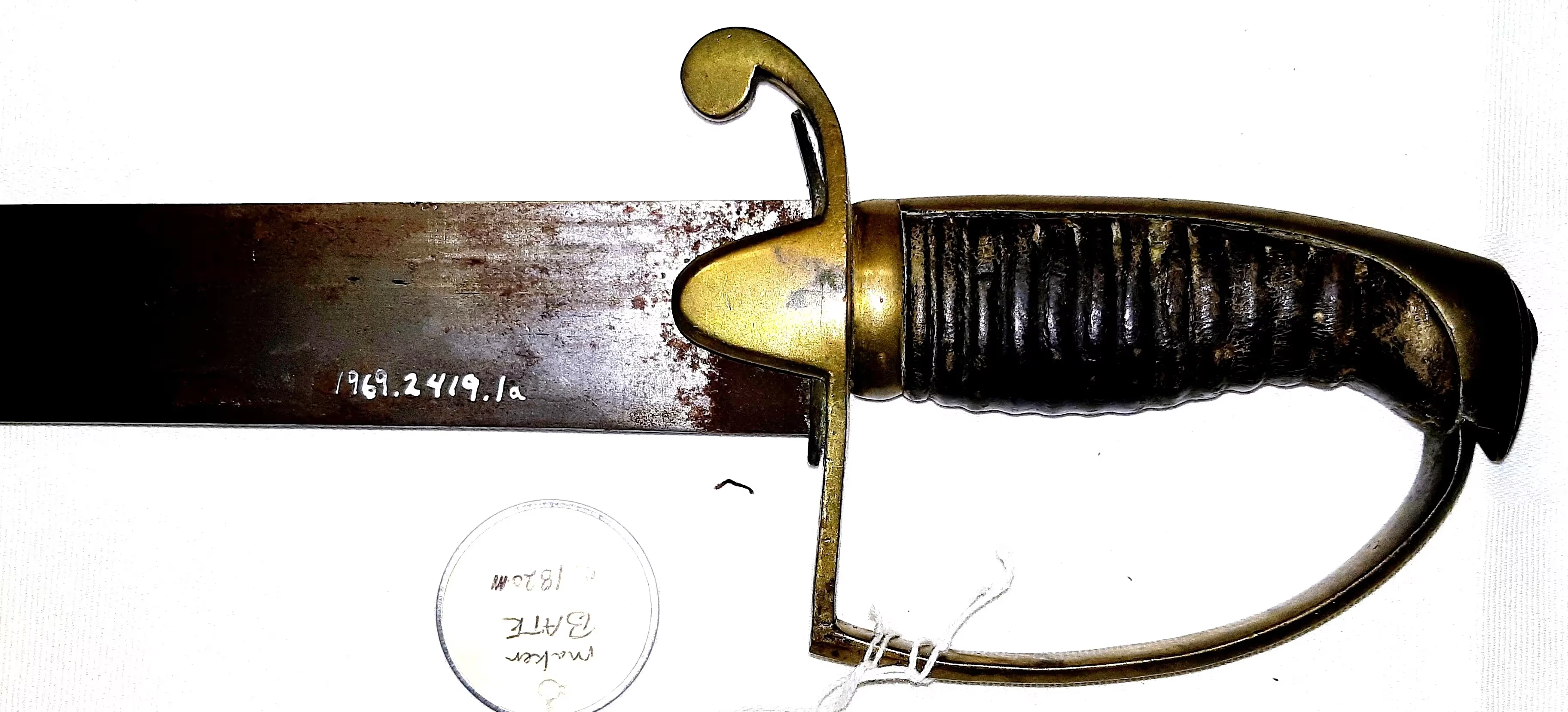

(Author Photos)
(Accession No. 1969.2419.1).
Short sabre with a broad blade, a brass hilt,guard and butt and with a black wooden handle. This sabre has a black leatherscabbard with a brass tip and mouth. “BATE” is inscribed on the back of theblade, and it has a ‘crown over 2’ proof mark on the ricasso.


(Author Photos)
(Accession No. 1969.2420.1)
Short sabre with a single-edges blade and a bronzecoloured hilt and a wooden grip. This sabre has a single-sided guard (with backside loops) and a square-like finger guard. The sabre is sharpened towards the pointof blade. It would appear that at some point after its manufacture, someonesharpened the metal, as the blade is partially double-edged.




(Author Photos)
(Accession No. 1969.2421.1).
Naval sword with a straight, steel blade, a wooden carved handle with black leather strips, a steel hilt and butt. There are five holes in guard. This weapon has a metal scabbard with two rings for a straphanger. "Osborn and Gunry" is etched on the blade. "Wooley, Deakin, Dutton, Johnson" is etched on the scabbard.


(Author Photos_
(Accession No. 1969.2422.1). Sword bayonet c1810, with a bronze handle and hilt. There is a rectangular vent on the left side of the handle revealing hollowness. The sword is heavily corroded. This sword bayonet was used with the Baker rifle. Baker rifles were used by Rifle Companies that were part of select battalions of New Brunswick Militia during the 1820s to 1840s period. The Northumberland Militia may have had a rifle company, in which case this sword bayonet was likely used by it. The bayonet is 69 cm (27.25 inches) in length with a 57 cm (22.5 inches)blade. (Gary Campbell)
(Accession No. 1969.2423.1).
Hand-made sword with a carved birch handle and a hand forged blade. The sides of the sword are parallel except where it is rounded at the tip. This sword appears to be similar to a machete. It was once the property of Bishop Dollard’s brother.
(Accession No. 1969.2424.1).
Epee, fencing.
(Accession No. 1969.2425.1).
Epee, fencing.
(Accession No. 1969.2426.1).
Epee, fencing.
(Accession No. 1969.2427.1),
Epee, fencing, missing handle grip.



(Author Photos)
(Accession No. 1969.2428.1).
Heavy Cavalry Troopers Sword and scabbard. Thissword has a single-edged, broad blade, and a wooden handle covered with blackleather. It has a metal hilt with a metal finger guard and a 360-degree handguard. There are five holes in hilt, possibly for decoration or alternatively,possibly to secure something. This sword has a straight, metal scabbard with tworings to hang it.


(Author Photos)
(Accession No. 1969.2479.3).
Royal Artillery dress Sword with scabbard. Thissword has a semi-basket guard and gold tassel. The grip is imitation snakeskinwith wire winding. The blade is elaborately etched. The scabbard is plainnickel plate.





(Author Photos)
(Accession No. 1969.2526.1).
Light Cavalry Officer’s Sword, P1821. This sword has a steel blade etched with a floral design and crown. The sword’s metal hilt ((is bound with sharkskin and wire.
(Accession No. 1969.2529.1).
Sword with “America” etched on its steel blade. This sword has a circular notched wooden hilt with a heart shaped guard. “NB # 405” is etched on the scabbard.
(Accession No. 1969.2530.1).
Sword with a broad blade and a metal hilt. Thehandle is painted black. It has a circular Spanish style hilt. The oval hilt guard has a floral attachmentand a broad, circular, 90-degree, shield-like finger guard. . "A& E. Holler Solingen" is etched on the blade. "NB # 405" isetched on the scabbard.

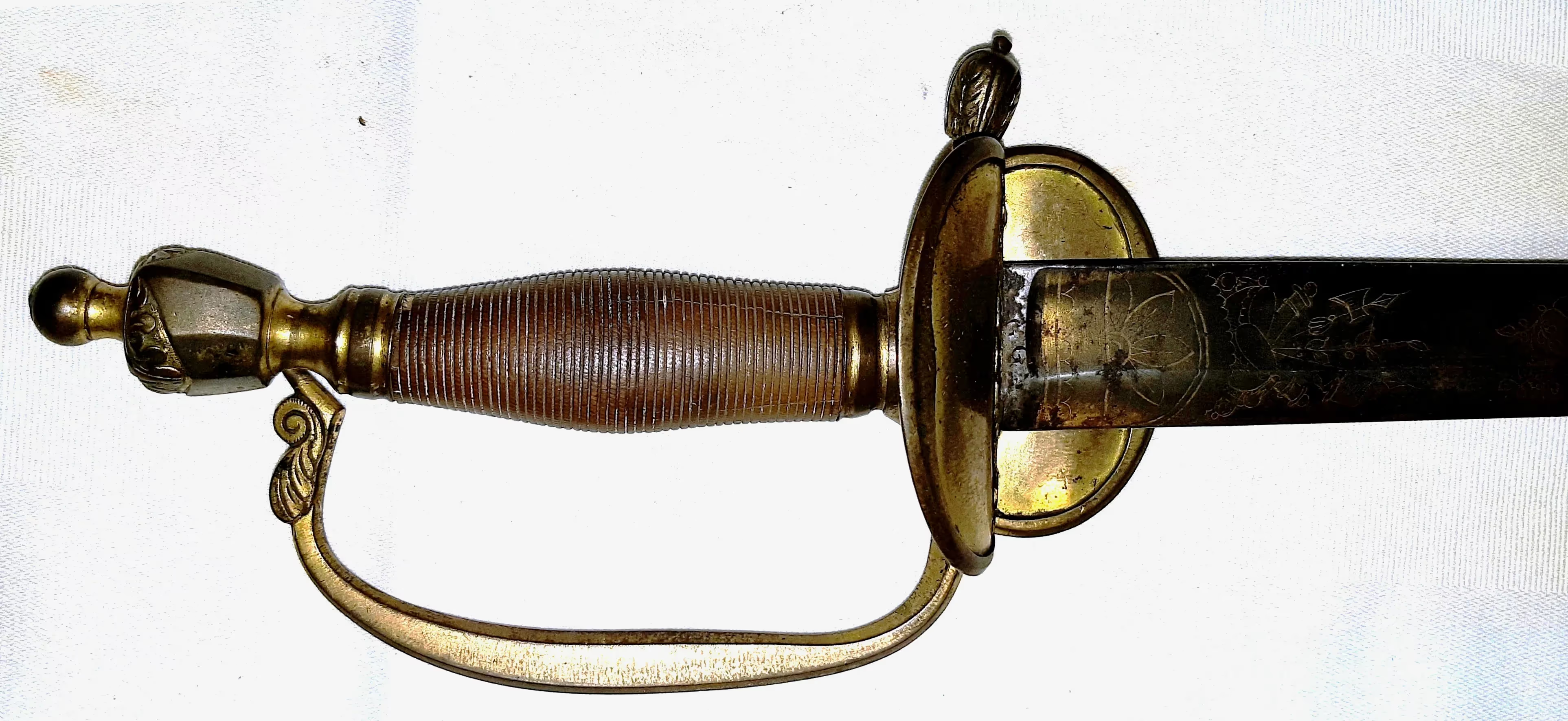

(Author Photos)
(Accession No. 1969.2956.1).
Infantry Officer’s sword, P1796, with a brass cross guard and hilt, wire handle, and a steel blade etched with a floral design. The hilt on one side swings on hinge. The sword bears a GR (King George III) cipher.

(Author Photo)
(Accession No. 1969.2957.1).
French Petit Montmorency Sabre with a steel blade that is broad and curved with an etched floral designs. This is a French officer's sabre dating back to the era of the reign of Louis XVI, the revolutionary period (1780-1795), the periods of the Directoire (1795-1799),and the (Napoleonic) consulate (1799-1804). This was a period offar-reaching social and political upheaval in France and its colonies. The French Petit Montmorency is a type of sabre that was carried by officers of the infantry, i.e. the chasseurs. It was made in France for use by light cavalry of the early modern and Napoleonic periods. It was used by various troops during the French Revolution until the 1790s, and was also carried in the Netherlands, in the period of the Batavian Republic. The sabre saw extensive military use in the early 19th century when Napoleon used heavy cavalry charges to great effect against his enemies. During the Revolution, they were made by many different private makers in an endless variety of designs but following the same general form.
The museum’s sabre has a very elaborate hilt and guard made of brass with a lion's head surrounded by leaves on the butt, and a with grip made of wood covered with leather with wire winding. It has a slightly curved 82-cm long broad steel blade of "petit montmorency" type with one cutting edge. The sabre's blade is etched with floral designs. This sabre belonged to Herbert Greene of Saint John. Mr. Green purchased this and another sword from Colonel Blare of Saint John, under whom Mr. Green had served as a Lieutenant, at some period in the early





(Author Photos)
(Accessio(Accession No. 1969.3061.1).
French Petit Montmorency Sabre with a steel blade that is broad and curved with an etched floral designs. This is a French officer's sabre dating back to the era of the reign of Louis XVI, the revolutionary period (1780-1795), the periods of the Directoire (1795-1799),and the (Napoleonic) consulate (1799-1804).
(Accession No. 1969.3061.1).
Sword with a slightly curved steel blade.
(Accession No. 1969.3116.1).
Sword with steel blade tempered blue near hiltwith a floral design. It has a brass aguard and hilt with a sharkskin and wire handle. This sword has a leather andbrass scabbard with a two ringed carrying strap. The strap is made up of twoleather pieces joined by a brass ring. One leather section is adjustable bylength.

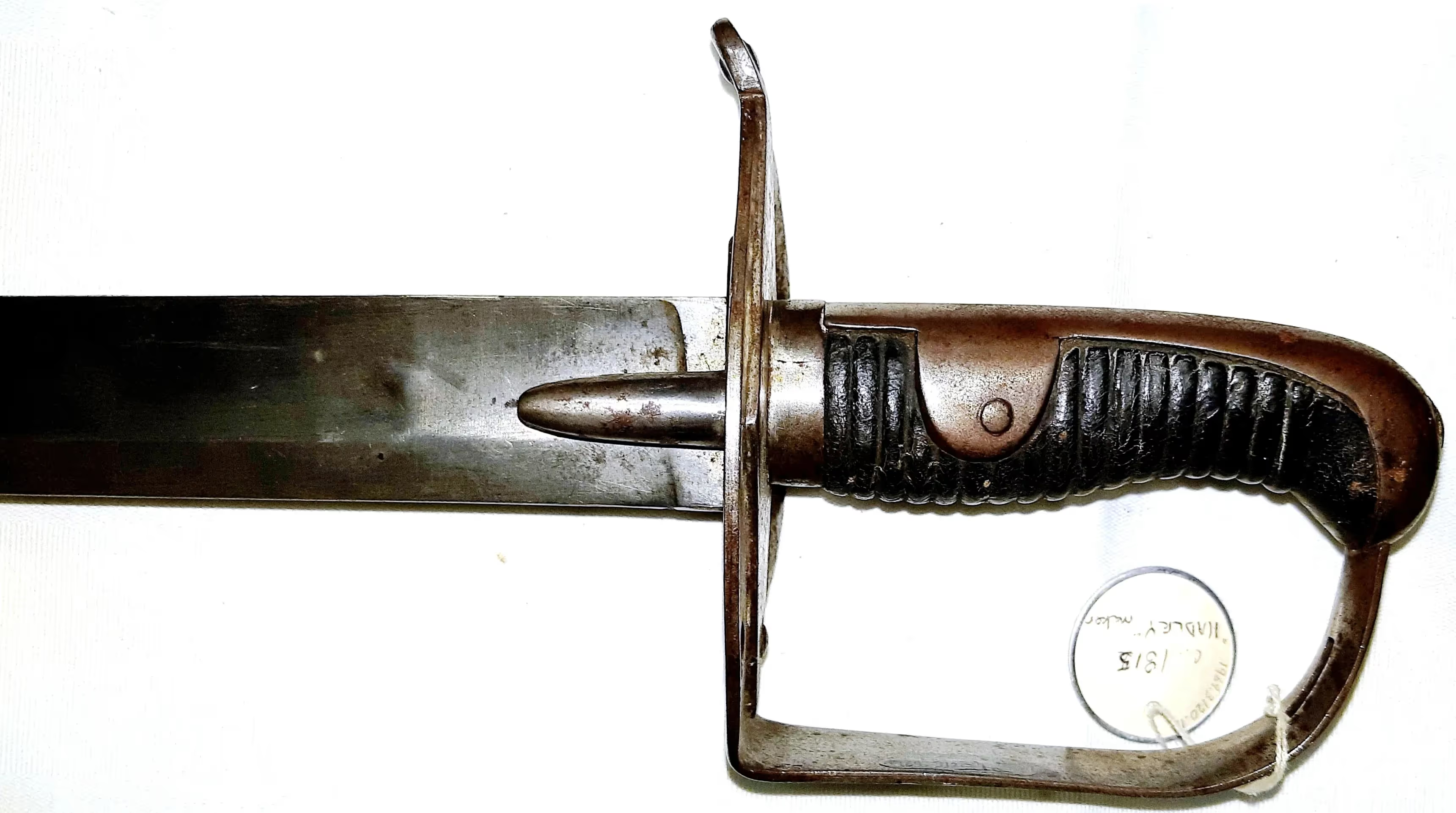

(Author Photos)
(Accession No. 1969.3120.1.
Straight, heavy Sword with a leather coveredhandle. The sword is marked Hadley, 1815.


(Author Photos)
(Accession No. 1969.3126.1)
Drummer’s Sword, P1856 Mk. 1. Dated 1869. This is a short sword etched with a VR ( Victoria) cypher. It is stamped with a double ‘broad arrow’ signifying that it was sold as surplus from the British Army, likely to the Canadian Militia. The blade comes to a double-edged point. The hilt is gold coloured with a snakes or vines crest on both sides. The guards of the hilt look like shamrocks. The sword handle is black leather and is secured between two metal fastenings. The upper fastening has a hook with a diamond. The lower metal fastening is secured by two nails.


(Accession No. 1969.3243.1)
Ivory handled Mameluke Sword with a slightly curved, single-edged blade with an etched floral and crown design. There is a Star of David on one side of blade. This sword has a metal and ivory hilt with a raised crown and oak leaves. The brass butt has a circular hole. The hilt is fastened together by two bolts which are engraved with flowers. Hilt has a double guard. At its centre is a crest of intertwined streams or designs. The hilt curves to one side at its base. The sword has a steel scabbard with two carrying rings and floral designs. There is a metal brass piece at the bottom of the scabbard with floral engravings. The main colour appears to have originally been silver.
(Accession No. 1969.3244.1).
Officer’s Light Cavalry Sabre with a stirrup hilt (very similar to the British P1788). This sword is engraved with a French inscription which means “do not draw me without reason”, “do not sheath me without honour”.





(Author Photos)'
(Accession No. 1969.3245.1).
Royal Artillery Officer's Dress Sword with a Wilkinson-type steel blade etched with a GVR (King George V) Cipher. The sword has a steel hilt, sharkskin and wire handle, with a gold cord and tassel tied to the hilt. This is likely a post First World War vintage sword. It has a steel scabbard with two hanging rings.





(Author Photos)
(Accession No. 1969.3246.1).
Sword with steel hilt, sharkskin and wirehandle. The steel blade is etched with “Henry Wilkinson”, “Pall Mall London”,and a “Star of David”. The markings on the blade are under a threefeather crest with the words “ich dier by appointment”.



.avif)

.avif)

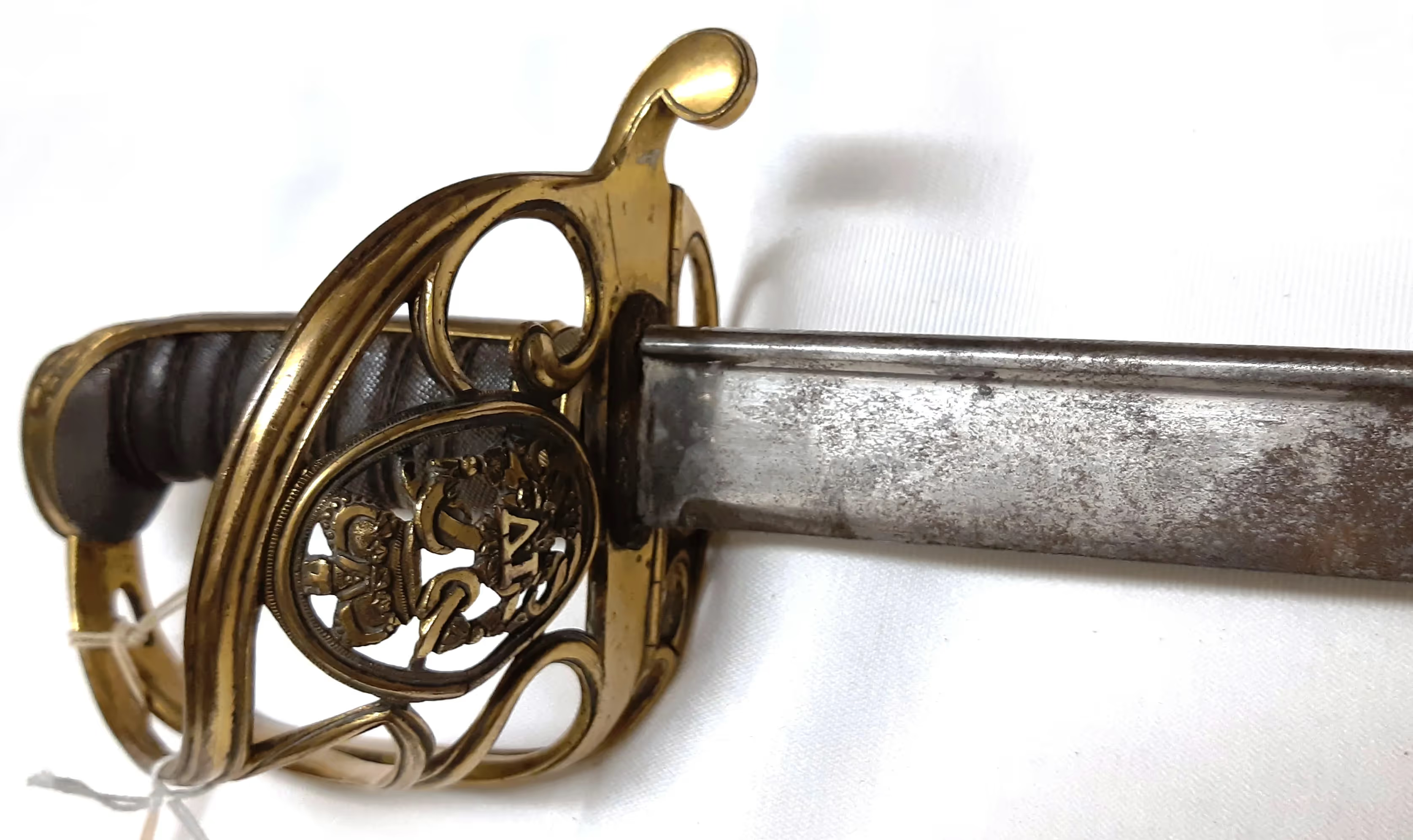



(Author Photos)
(Accession No. 1969.3247.1).
Infantry Officer’s Sword, P1822, King George IV, c1830s. The sword has a straight tapered steel blade, a brass cross-guard and butt, with a sharkskin handle. The hilt is gold coloured. The guard is only a half-guard.



(Author Photos)
(Accession No. 1969.3248.1).
Sword with a heavy, broad curved blade with a metalcross guard and butt. It has a wooden covered handle and a squared finger guardthat rounds at the bottom. This sword has a steel two-ringed curved scabbard.

(Author Photo)
(Accession No. 1969.3356.1).
Concealed sword in a hollowed out wood walkingcane. The can has a yellow plastic handle, armed with a spike blade.



(Author Photos)
(Accession No. 1973.1.57)
Sword with a steel blade and an ivory andbrass hilt. “Ames Mfg. Co” and “Chicopes,Mass” is etched on the blade. This swordhas a red leather scabbard with a brass top and tip, and a leather pouch withstrap. Etched on the scabbard: “In HocSino Vinces” (Latin phrase conventionally translated into English as “In thissign thou shalt conquer”.






(Author Photos)
(Accession No. 1974.3.1).
Infantry Officer’s Sword with a single edge and two-sided point. The curved handle has a tooled leather insert, sharkskin covering and raised bands for a firmer grip. It has gold filigree trim with the British cypher VR (Queen Victoria) in an oval with a crown and shamrock. There is a rose and thistle pattern at the lower base of the oval shape. The blade has an etched floral pattern extending to within 30 cm of the tip. The sword’s scabbard is metal with a khaki chamois cover; two hanging rings. It has a white over-the-shoulder leather sword strap and belt with an "S" hook hanging from ring at the waist. The Royal monogram or cypher is engraved on a brass buckle. The blade is etched with: "Firmin and Sons, 153 Strand and13 Conduit St., London". The strap and belt has: "UR," and "New Brunswick Militia," and 'Firmin and Sons, London," and"11".
(Accession No. 1975.4.2).
Sword with a spear point, single edged brassprotector plates (shells) of which the left one hinges narrow knuckle brow,right side of blade has a floral design. British coat of arms surmountedby a crown. On coat of arms: “HONI SOIT QUI MAL Y PE”, “DIEU ET MONDROIT”, “warrented”, stamped near the hilt: “G.G.”
(Accession No. 1980.10.8).
Sword.
(Accession No. 1975.4.4).
Sword with scabbard.
(Accession No. 1975.4.5).
Sword.

(Accession No. 1980.10.8).
British Officer’s Naval Dirk.
(Accession No. 1981.2.25).
Sword sling. Two adjustable, leather straps attached to leather pouch, forming a V. Each strap has a brass buckle. Worn by Lieutenant-General Sansom. Straps fasten onto a Sam Browne Belt and the sword would be worn through flaps in the pouch.

(Accession No. 1983.1.1).
Sword with a brass coloured basket with sharkskin grip. Queen Victoria Cipher. Gold and scarlet cloth tassel attached. Crown on both sides with floral design. Crown crest resting on flowers. Proved point is gold and makes up centre of flower. Hilt has a guard that flips up on hinge. B - Silver coloured. Metal with two metal loops to attach to sword sling. (Under glass in a display cabinet, 2nd floor).
(Accession No. 1987.3.37).
Sword with an allmetal handle with a braided design. It has a gold cord and toggle. This sword has a straight, metal,silver-coloured scabbard with two hanging rings. It is etched with a GVR(King George V) cypher. It is likely post- First World War vintage. (
(Accession No. 1994.19.17).
German sword, (no data).
(Accession No. 2008.13.1).
Sword, Pattern 1796, Heavy Cavalry Officer's Dress Sword. The 1796 Heavy Cavalry sword is perhaps the most famous and clearest examples of a sword with hatchet points but proved to be poor in the thrust (it had been designed for the melee after cavalry merged with the enemy). Many were therefore ground down to have spearpoints capable of thrusting, particularly for the initial merge.
(Accession No. 2008.23.1).
Sword, dress or presentation, c 1910. This sword has a copper handle with an elaborate hand shield (with a German-type coat of arms on it) and a stainless-steel blade. Quite possibly of German origin. 94 cm long, 10 cm wide at the hilt - but 2 cm wide at the blade. It has a leather scabbard, 83 cm long and 2 cm wide.


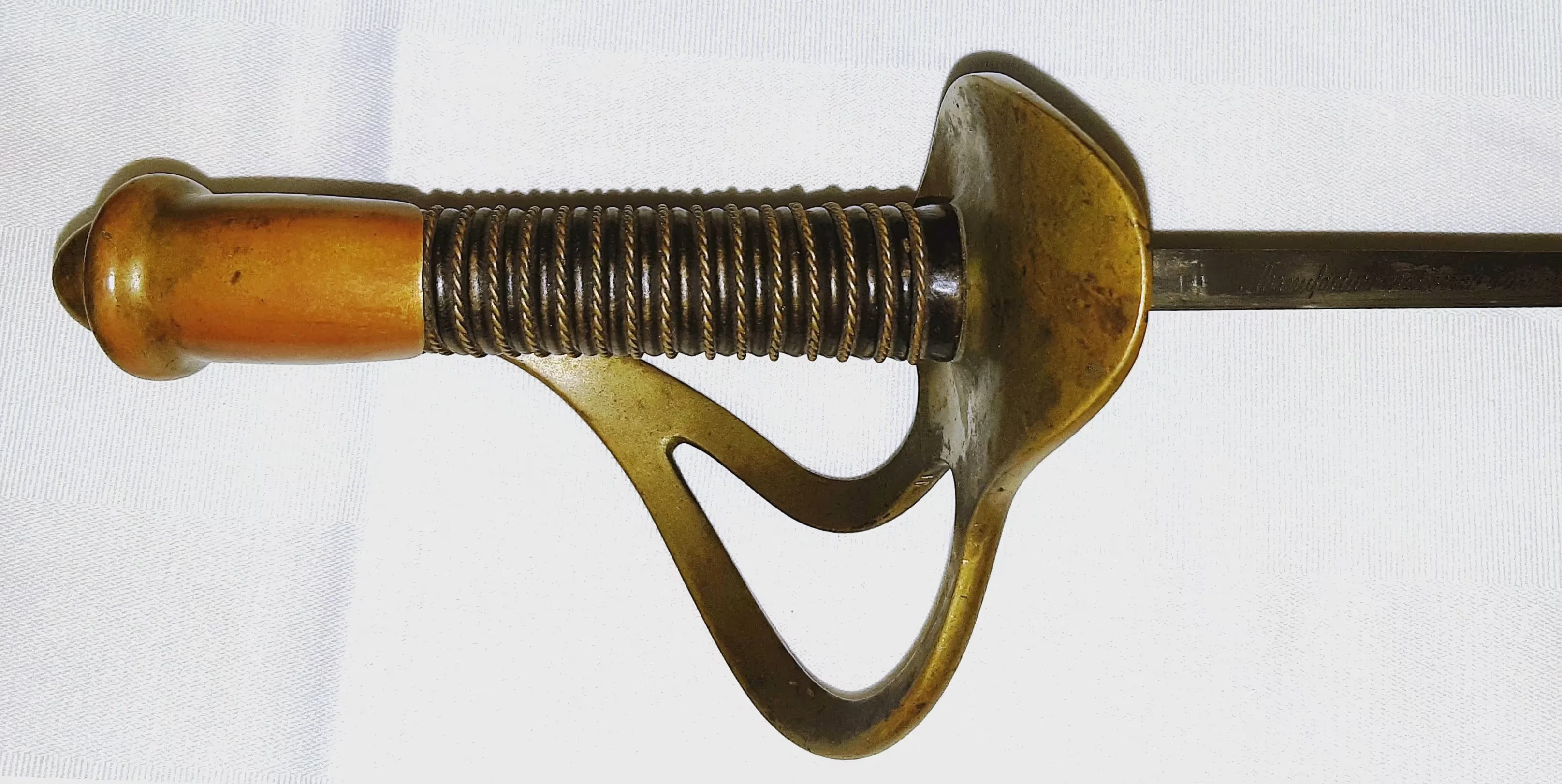


(Author Photos)
(Accession No. 2012.9.1).
French Sword with heavy gold-colored handleand a long curved blade. The blade hastwo grooves and is pointed at the edge. It is marked Manufacture nationald’armes de Chatelleraut, Julliet 1913, Dragon Me 1892.





(Accession No. 2014.11.1).
Sword with plain basket guard, snakeskin hilt,steel blade, leather scabbard. 16008 is engrave on the back edge of the blade, close to the guard.


(Accession No. 2014.13.1).
Sword with basket hilt, long narrow steel blade, ca 1880.
Accession No. 2014.16.3).
Sabre with a steel blade, broad and curved with etched floral designs. Very elaborate hilt and guard, brass with leaves and a lion's head on the butt.
.




(York Sunbury Historical Society, Fredericton Region Museum Collection, Author Photos)
(Accession No. 1969.2412.1).
Japanese Katana Samurai sword with a steel blade and a wooden handle covered with rough, beige, sharkskin (grey diamond shapes). The sword has a circular hand guard composed at least partially of iron with an inlaid pattern of floral and other designs. The bottom of hilt has dragon designs. It has a wooden scabbard wrapped in black and white sharkskin. It has a black tip and black knob with a hole meant to hold a cord.




(Doug Hall Collection, temporary loan to the museum_
Sword, Swiss Army Officer's Sword, M1899 with metal scabbard.

(Library and Archives Canada Photo, MIKAN No. 3635711)
1914-1918 recruiting poster.

(Library and Archives Canada Photo, MIKAN No. 3401252)
Canadian soldier carrying captured German First World War swords.

(Library and Archives Canada Photo, MIKAN No. 3401252)
Captured German First World War swords and medals.

(Library and Archives Canada Photo, MIKAN No. 3401239)
Captured German First World War medals and decorations.

